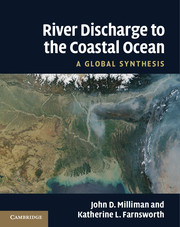Book contents
- Frontmatter
- Contents
- Foreword
- 1 Introduction
- 2 Runoff, erosion, and delivery to the coastal ocean
- 3 Temporal variations
- 4 Human activities and their impacts
- Appendices. Global river data base
- Appendix A North and Central America
- Appendix B South America
- Appendix C Europe
- Appendix D Africa
- Appendix E Eurasia
- Appendix F Asia
- Appendix G Oceania
- References
- Indexes
1 - Introduction
Published online by Cambridge University Press: 03 May 2011
- Frontmatter
- Contents
- Foreword
- 1 Introduction
- 2 Runoff, erosion, and delivery to the coastal ocean
- 3 Temporal variations
- 4 Human activities and their impacts
- Appendices. Global river data base
- Appendix A North and Central America
- Appendix B South America
- Appendix C Europe
- Appendix D Africa
- Appendix E Eurasia
- Appendix F Asia
- Appendix G Oceania
- References
- Indexes
Summary
“Data! Data! Data!” (Holmes) cried impatiently.
“I cannot make bricks without clay.”
Dr. J. Watson as transmitted to A. Conan Doyle“Give me the facts, Ashley,
and I will twist them the way I want to suit my argument”
(statement attributed to W. Churchill)Rivers and the coastal ocean
Rivers provide the primary link between land and sea, annually discharging about 36 thousand km3 of freshwater and more than 20 billion tons (Bt) of solid and dissolved material to the world ocean. These fluxes, together with physiography and oceanographic setting, help determine the character of the estuarine and coastal environment. Although discharged water and sediments are generally confined to the coastal zone, if a flood is sufficiently large (e.g. Amazon River) or the shelf sufficiently narrow (e.g. southern California or eastern Taiwan) fluvial-driven plumes can extend to or beyond the shelf edge. In addition to their link to the coastal ocean, rivers historically have played key roles in human habitation and history, providing water, nutrients, transportation, and protection, among other things, for people living within their drainage basins.
Because of the wide range of physical and societal functions that a river can serve, one appealing – yet also daunting – aspect in the study of rivers and their watersheds is the diversity of perspectives and approaches used in their study. Geochemists and geologists often view a river in terms of landscape denudation or sediment transport, whereas geomorphologists may be more concerned with landscape character and its evolution.
- Type
- Chapter
- Information
- River Discharge to the Coastal OceanA Global Synthesis, pp. 1 - 12Publisher: Cambridge University PressPrint publication year: 2011
- 2
- Cited by



